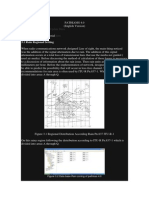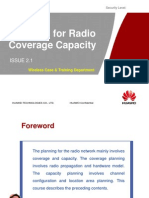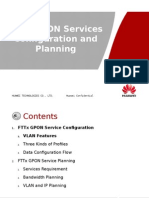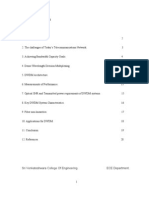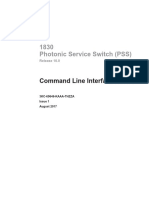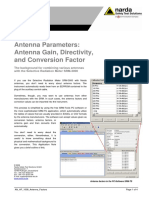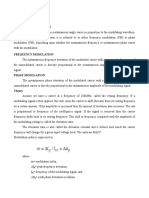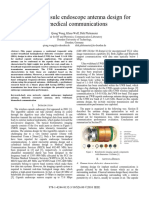Pathloss Training NEC
Pathloss Training NEC
Uploaded by
Babar Nawaz KhanCopyright:
Available Formats
Pathloss Training NEC
Pathloss Training NEC
Uploaded by
Babar Nawaz KhanOriginal Description:
Original Title
Copyright
Available Formats
Share this document
Did you find this document useful?
Is this content inappropriate?
Copyright:
Available Formats
Pathloss Training NEC
Pathloss Training NEC
Uploaded by
Babar Nawaz KhanCopyright:
Available Formats
PATHLOSS TRAINING COURSE
INTRODUCTION To PATHLOSS
March 17, 2009 NEC Corporation Islamabad
1
NEC Internal Use Only
Page 2
GENERAL PROGRAME OUTLINE
Path Loss program is organized into the 8 following modules: Module 01: Module 02: Module 03: Module 04: Module 05: Module 06: Module 07: Module 08: Summary Terrain Data Antenna Heights Worksheets Diffraction Reflection Multipath Network
2
NEC Internal Use Only
NEC Internal Use Only
Page 3
COURSE OUTLINE
Module 01: Module 02: Module 03: Module 04: Q&A Summary Terrain Data Antenna Heights Worksheet
3
NEC Internal Use Only
NEC Internal Use Only
Page 4
Module 1: SUMMARY MODULE
4
NEC Internal Use Only
NEC Internal Use Only
Page 5
Module 1: SUMMARY MODULE
5
NEC Internal Use Only
NEC Internal Use Only
Page 6
Module 1: SUMMARY MODULE
6
NEC Internal Use Only
NEC Internal Use Only
Page 7
Module 1: SUMMARY MODULE
7
NEC Internal Use Only
NEC Internal Use Only
Page 8
Module 1: SUMMARY MODULE
8
NEC Internal Use Only
NEC Internal Use Only
Page 9
Module 2: Terrain Data Module
Basic procedures to create a Terrain Profiles Survey Angle calculation Global 30 ARC Second Database SRTM Database. Profile Generation
9
NEC Internal Use Only
NEC Internal Use Only
Page 10
Module 2: Terrain Data Module (contd)
10
NEC Internal Use Only
NEC Internal Use Only
Page 11
Module 2: Terrain Data Module (contd)
11
NEC Internal Use Only
NEC Internal Use Only
Page 12
Module 2: Terrain Data Module (contd)
12
NEC Internal Use Only
NEC Internal Use Only
Page 13
Module 2: Terrain Data Module (contd)
13
NEC Internal Use Only
NEC Internal Use Only
Page 14
Module 2: Terrain Data Module (contd)
14
NEC Internal Use Only
NEC Internal Use Only
Page 15
Module 2: Terrain Data Module (contd)
15
NEC Internal Use Only
NEC Internal Use Only
Page 16
Module 2: Terrain Data Module (contd)
16
NEC Internal Use Only
NEC Internal Use Only
Page 17
Module 2: Terrain Data Module (contd)
17
NEC Internal Use Only
NEC Internal Use Only
Page 18
Module 2: Terrain Data Module (contd)
18
NEC Internal Use Only
NEC Internal Use Only
Page 19
Module 2: Terrain Data Module (contd)
19
NEC Internal Use Only
NEC Internal Use Only
Page 20
Module 2: Terrain Data Module (contd)
20
NEC Internal Use Only
NEC Internal Use Only
Page 21
Module 2: Terrain Data Module (contd)
21
NEC Internal Use Only
NEC Internal Use Only
Page 22
Module 2: Terrain Data Module (contd)
22
NEC Internal Use Only
NEC Internal Use Only
Page 23
Module 2: Terrain Data Module (contd)
23
NEC Internal Use Only
NEC Internal Use Only
Page 24
Module 2: Terrain Data Module GTOPO30
GTOPO30 is a global digital elevation model (DEM) with a horizontal grid spacing of 30 arc seconds (approximately 1 kilometer). GTOPO30, completed in late 1996, was developed over a three year period . The absolute vertical accuracy of GTOPO30 varies by location according to the source data. The full resolution have a vertical accuracy of + or - 30 meters.
24
NEC Internal Use Only
NEC Internal Use Only
Page 25
Module 2: Terrain Data Module SRTM
SRTM is a 90m Digital Elevation Data for the entire world. Originally produced by NASA, is a major breakthrough in digital mapping of the world, and provides a major advance in the accessibility of high quality elevation data for large portions of the tropics and other areas of the developing world. The NASA Shuttle Radar Topographic Mission (SRTM) has provided digital elevation data (DEMs) for over 80% of the globe. The SRTM data is available as 3 arc second (approx. 90m resolution) DEMs. A 1 arc second data product was also produced, but is not available for all countries.
25
NEC Internal Use Only
NEC Internal Use Only
Page 26
Module 3: Antenna Height Module
Basic Operations, Setting Clearance Criteria, Clearance Calculation at a point, Antenna height Considerations, Setting Antenna Heights, Optimizing Antenna heights, Report Generations
26
NEC Internal Use Only
NEC Internal Use Only
Page 27
Module 3:Antenna Height Module (contd)
27
NEC Internal Use Only
NEC Internal Use Only
Page 28
Module 3:Antenna Height Module (contd)
28
NEC Internal Use Only
NEC Internal Use Only
Page 29
Module 3:Antenna Height Module (contd)
29
NEC Internal Use Only
NEC Internal Use Only
Page 30
Module 3:Antenna Height Module (contd)
30
NEC Internal Use Only
NEC Internal Use Only
Page 31
Module 4: Worksheet Module
Overview Antenna Configurations Reliability Options Diversity options Microwave Worksheet Options Look up Tables
31
NEC Internal Use Only
NEC Internal Use Only
Page 32
Module 4: Worksheet Module (contd)
32
NEC Internal Use Only
NEC Internal Use Only
Page 33
Module 4: Worksheet Module (contd)
33
NEC Internal Use Only
NEC Internal Use Only
Page 34
Module 4: Worksheet Module (contd)
34
NEC Internal Use Only
NEC Internal Use Only
Page 35
Module 4: Worksheet Module (contd)
35
NEC Internal Use Only
NEC Internal Use Only
Page 36
Module 4: Worksheet Module (contd)
36
NEC Internal Use Only
NEC Internal Use Only
Page 37
Module 4: Worksheet Module (contd)
37
NEC Internal Use Only
NEC Internal Use Only
Page 38
Module 4: Worksheet Module (contd)
38
NEC Internal Use Only
NEC Internal Use Only
Page 39
Module 4: Worksheet Module (contd)
39
NEC Internal Use Only
NEC Internal Use Only
Page 40
Module 4: Worksheet Module (contd)
40
NEC Internal Use Only
NEC Internal Use Only
Page 41
Module 4: Worksheet Module (contd)
41
NEC Internal Use Only
NEC Internal Use Only
Page 42
Module 4: Worksheet Module (contd)
42
NEC Internal Use Only
NEC Internal Use Only
Page 43
Module 5: Diffraction Module
Overview, Diffraction loss variation with K-factor Diffraction loss variation with different algorithms Diffraction loss variation with height variation
43
NEC Internal Use Only
NEC Internal Use Only
Page 44
Module 5: Diffraction Module (contd)
Diffraction of microwave beam occurs when the beam center line grazes over an obstacle and RF energy reaching the far antenna is attenuated. Diffraction creates a small shadow region where some energy is re directed in a narrow and rapidly diminishing wedge toward total shadow.
44
NEC Internal Use Only
NEC Internal Use Only
Page 45
Module 5: Diffraction Module (contd)
The actual amount of diffraction is dependent upon: The Fresnel Zone Radius of the wave front at the obstruction point The Size and Shape of the obstruction and The Reflectivity of the obstruction.
3rd
2nd 1st Fresnel Zones
45
NEC Internal Use Only
NEC Internal Use Only
Page 46
Module 5: Diffraction Module (contd)
46
NEC Internal Use Only
NEC Internal Use Only
Page 47
Module 5: Diffraction Module (contd)
47
NEC Internal Use Only
NEC Internal Use Only
Page 48
Module 5: Diffraction Module (contd)
48
NEC Internal Use Only
NEC Internal Use Only
Page 49
Module 5: Diffraction Module (contd)
49
NEC Internal Use Only
NEC Internal Use Only
Page 50
Module 5: Diffraction Module (contd)
50
NEC Internal Use Only
NEC Internal Use Only
Page 51
Module 6: Reflection Module
Reflective Plan Definition, Terrain Roughness, Variable Parameters, Dispersion Analysis,
51
NEC Internal Use Only
NEC Internal Use Only
Page 52
Module 6: Reflection Module
Reflection occurs when radio waves strike: A smooth surface such as water, sheet of Ice in winter A smooth earth The boundary between the adjacent atmospheric layers of different densities.
52
NEC Internal Use Only
NEC Internal Use Only
Page 53
Module 6: Reflection Module (contd)
Depending on the length of the reflected path, the reflected wave may arrive at the receive antenna either:
In phase, Out of phase or Partially out of phase
53
NEC Internal Use Only
NEC Internal Use Only
Page 54
Module 6: Reflection Module (contd)
54
NEC Internal Use Only
NEC Internal Use Only
Page 55
Module 6: Reflection Module (contd)
55
NEC Internal Use Only
NEC Internal Use Only
Page 56
Module 6: Reflection Module (contd)
56
NEC Internal Use Only
NEC Internal Use Only
Page 57
Module 6: Reflection Module (contd)
57
NEC Internal Use Only
NEC Internal Use Only
Page 58
Module 6: Reflection Module (contd)
58
NEC Internal Use Only
NEC Internal Use Only
Page 59
Module 6: Reflection Module (contd)
59
NEC Internal Use Only
NEC Internal Use Only
Page 60
Module 7: Multipath Module
Overview, Constant Gradient Method Variable Gradient Method
60
NEC Internal Use Only
NEC Internal Use Only
Page 61
Module 7: Multipath Module
61
NEC Internal Use Only
NEC Internal Use Only
Page 62
Module 7: Multipath Module (Contd)
62
NEC Internal Use Only
NEC Internal Use Only
Page 63
Module 7: Multipath Module (Contd)
63
NEC Internal Use Only
NEC Internal Use Only
Page 64
Module 7: Multipath Module (Contd)
64
NEC Internal Use Only
NEC Internal Use Only
Page 65
Module 7: Multipath Module (Contd)
65
NEC Internal Use Only
NEC Internal Use Only
Page 66
Module 7: Multipath Module (Contd)
66
NEC Internal Use Only
NEC Internal Use Only
Page 67
Module 8: Network Module
Overview, Interference calculation procedure, Interference Calculations
67
NEC Internal Use Only
NEC Internal Use Only
Page 68
Module 8: Network Module (Contd)
68
NEC Internal Use Only
NEC Internal Use Only
Page 69
Module 8: Network Module (Contd)
69
NEC Internal Use Only
NEC Internal Use Only
Page 70
Module 8: Network Module (Contd)
70
NEC Internal Use Only
NEC Internal Use Only
Page 71
Module 8: Network Module (Contd)
The simplified RL networks are used to illustrate the calculation procedure.
RECTANGULAR NETWORK
NEC Internal Use Only
TRIANGULAR NETWORK
71
NEC Internal Use Only
Page 72
Module 8: Network Module (Contd)
Obtain the following information to determine where interference analysis is needed in the network: Frequency Bands If the network frequency plan uses different frequencies then there is no need to analyze these links for interference. For example use of 7 and 13 GHz bands together.
Available Frequency Pairs
For example a two frequency plan as opposed to a four frequency plan. Number of pairs determine how often the frequencies are repeated. System Layout ( to scale) This will indicate possible cases of interferences in the network
72
NEC Internal Use Only
NEC Internal Use Only
Page 73
Module 8: Network Module (Contd)
Distance between paths Distances over 150 Km an be ignored, however short distances or co located sites must be analyzed for interference. Terrain Mountains between sites will block an interfering signal, however sites located on mountain tops must be investigated for possible interference. Exaggerated Azimuths 90 180 degrees may not require interference analysis.
73
NEC Internal Use Only
NEC Internal Use Only
Page 74
Module 8: Network Module (Contd)
Antenna Patterns
These should be based on polarizations schemes such as HH, VV, HV, VH used in the network and shall be available for both, the victim receiver and the interfering transmitter.
Path Calculations These should include: Victim Path, Interfering Path and interfering path to victim receiver.
74
NEC Internal Use Only
NEC Internal Use Only
Page 75
Module 8: Network Module (Contd)
Consider any of the following options to meet the required interference objectives:
Antenna Changes: Use larger diameter antenna to increase gain Use High performance antennas to achieve higher levels of discrimination X pole discrimination
Adjust Power Output
Use other frequency assignments Re route the link
75
NEC Internal Use Only
NEC Internal Use Only
Page 76
Module 8: Network Module (Contd)
76
NEC Internal Use Only
NEC Internal Use Only
THANK YOU
77
NEC Internal Use Only
You might also like
- Basic Microwave PPT - V2.2Document147 pagesBasic Microwave PPT - V2.2mohamudNo ratings yet
- Digital Microwave CommunicationDocument113 pagesDigital Microwave CommunicationRakesh Yadav100% (2)
- DWDM Transmode GoodDocument89 pagesDWDM Transmode GoodSanjay YadavNo ratings yet
- DWDM BasicsDocument82 pagesDWDM BasicsstevoltgutsyNo ratings yet
- Kpi MicrowaveDocument2 pagesKpi Microwave12345password0100% (3)
- Infinera IEEE OTN OverviewDocument25 pagesInfinera IEEE OTN OverviewTaha Ben AmorNo ratings yet
- Digital Microwave Communication Principles V1.0Document144 pagesDigital Microwave Communication Principles V1.0patrickkis294923100% (9)
- Point To Point Microwave 1Document81 pagesPoint To Point Microwave 1karwan chawmar100% (1)
- Routine Maintenance and Troubleshooting For DWDMDocument73 pagesRoutine Maintenance and Troubleshooting For DWDMDo Khanh Nam100% (2)
- GSM KPI Optimization Process and GuideDocument22 pagesGSM KPI Optimization Process and GuideZouhir El AllaouiNo ratings yet
- Beamforming Basics in SONARDocument22 pagesBeamforming Basics in SONARabhishek100% (2)
- Understanding UMTS Radio Network Modelling, Planning and Automated Optimisation: Theory and PracticeFrom EverandUnderstanding UMTS Radio Network Modelling, Planning and Automated Optimisation: Theory and PracticeMaciej NawrockiNo ratings yet
- Fundamentals of Cellular Network Planning and Optimisation: 2G/2.5G/3G... Evolution to 4GFrom EverandFundamentals of Cellular Network Planning and Optimisation: 2G/2.5G/3G... Evolution to 4GNo ratings yet
- Fundamentals of Network Planning and Optimisation 2G/3G/4G: Evolution to 5GFrom EverandFundamentals of Network Planning and Optimisation 2G/3G/4G: Evolution to 5GNo ratings yet
- Pathloss 4.0 GuideDocument52 pagesPathloss 4.0 GuideAlex100% (1)
- RTN 910/950 Dimmensioning: IntroducingDocument94 pagesRTN 910/950 Dimmensioning: IntroducingGaddy GumbaoNo ratings yet
- Pathloss 4 TutorialDocument10 pagesPathloss 4 Tutorialluigui023No ratings yet
- Microwave - Pathloss IV TrainingDocument3 pagesMicrowave - Pathloss IV TrainingbantunnaNo ratings yet
- MW Planning With Path Loss 4Document57 pagesMW Planning With Path Loss 4kamkamtoy100% (1)
- Components For DWDM Systems: A. ZarifkarDocument111 pagesComponents For DWDM Systems: A. ZarifkarBui TheQuanNo ratings yet
- Microwave BasicsDocument37 pagesMicrowave BasicsSheenly Joy Abalajen0% (1)
- Topic On Microwave XPIC-BDocument20 pagesTopic On Microwave XPIC-BHUgo Medrano100% (4)
- Huawei RTN 900 SeriesDocument2 pagesHuawei RTN 900 SeriesmarcelobetelNo ratings yet
- NEC Level-1 Training PresentationDocument66 pagesNEC Level-1 Training PresentationM Tanvir Anwar100% (1)
- IP Services - Aviat Network Services For IP Networks (Data Sheet) - 08may15 PDFDocument4 pagesIP Services - Aviat Network Services For IP Networks (Data Sheet) - 08may15 PDFJelica KovacNo ratings yet
- G-LII 202 Planning For Radio Coverage Capacity-20080312-A-2.1Document26 pagesG-LII 202 Planning For Radio Coverage Capacity-20080312-A-2.1naveedalishaNo ratings yet
- Microwave Transmission EngineerDocument5 pagesMicrowave Transmission EngineerGaurav SaraswatNo ratings yet
- 6500 Reconfigurable Line System DSDocument4 pages6500 Reconfigurable Line System DSsrilekhaNo ratings yet
- Overview of PON Technologies and System ArchitecturesDocument56 pagesOverview of PON Technologies and System ArchitecturesElie Eklu50% (2)
- Micowave Survey Knowledge-20080226-ADocument114 pagesMicowave Survey Knowledge-20080226-AFerry Kurniawan100% (4)
- MW TXN and RTNDocument105 pagesMW TXN and RTNHAWLITUNo ratings yet
- MW Planning IntroductionDocument36 pagesMW Planning IntroductionMahmoud Taha67% (3)
- Introduction To Optical NetworkingDocument39 pagesIntroduction To Optical NetworkingshahabniaziNo ratings yet
- 07 FTTX GPON Services Data Planning and ConfigurationDocument34 pages07 FTTX GPON Services Data Planning and Configurationbclarke113No ratings yet
- DWDM SystemDocument51 pagesDWDM Systemgptsiva50% (2)
- Point To Point MicrowaveDocument81 pagesPoint To Point MicrowaveRicha BudhirajaNo ratings yet
- Microwave Fundamentals: Proprietary & Confidential SlideDocument88 pagesMicrowave Fundamentals: Proprietary & Confidential SlideBharat Dwivedi100% (1)
- Long Haul Installation GuideDocument27 pagesLong Haul Installation GuideJorge HerreraNo ratings yet
- Training On Microwave Communcation: by Nilesh PatelDocument39 pagesTraining On Microwave Communcation: by Nilesh PatelKo AungNo ratings yet
- Transmission System: Low Capacity Transmission. High Capacity Transmission. Optical Fibre. Network ConfigurationDocument23 pagesTransmission System: Low Capacity Transmission. High Capacity Transmission. Optical Fibre. Network ConfigurationPantha GhosalNo ratings yet
- Pathloss 5Document11 pagesPathloss 5Malay Palai100% (2)
- DWDM ReportDocument21 pagesDWDM ReportlovelyvirgoNo ratings yet
- 2014 Huawei Microwave Backhaul Solution v1.0 (20140317)Document134 pages2014 Huawei Microwave Backhaul Solution v1.0 (20140317)Hien NguyenNo ratings yet
- Design and Test Technologies of A RepeaterDocument24 pagesDesign and Test Technologies of A Repeaternarges5058100% (1)
- Ceragon - Book - IP10G - ADV - V1.5Document312 pagesCeragon - Book - IP10G - ADV - V1.5Loi Nguyen Tho100% (2)
- Operation & Maintenance Training (Rev2.1) Part 1.2Document110 pagesOperation & Maintenance Training (Rev2.1) Part 1.2bbiswajit88eceNo ratings yet
- OTNNPDocument1 pageOTNNPsrotenstein3114100% (1)
- Microwave Link DesignDocument47 pagesMicrowave Link Designsanjaybhad67% (3)
- WDM PrincipleDocument54 pagesWDM PrincipleRandy Dookheran100% (2)
- Topic On The Service Configuration of The OptiX RTN 900 V100R001-20090812-ADocument108 pagesTopic On The Service Configuration of The OptiX RTN 900 V100R001-20090812-AAbu-Abdullah SameerNo ratings yet
- Huawei OTN Product Series BrochureDocument8 pagesHuawei OTN Product Series Brochurescribd01No ratings yet
- 3KC69646KAAATHZZA - V1 - 1830 Photonic Service Switch (PSS) Release 10.0 Command Line Interface GuideDocument7,772 pages3KC69646KAAATHZZA - V1 - 1830 Photonic Service Switch (PSS) Release 10.0 Command Line Interface GuideselvscribdNo ratings yet
- Microwave Basic Theory: - Optical Engineering DepDocument22 pagesMicrowave Basic Theory: - Optical Engineering DepMuhammad Fahad HafeezNo ratings yet
- WDM System CommissioningDocument107 pagesWDM System CommissioningFlavio VidalNo ratings yet
- EXFO Reference-Poster 100GDocument2 pagesEXFO Reference-Poster 100GLuis Campoverde100% (1)
- Microwave Principles: Knowledge Service Dept. Microwave TeamDocument48 pagesMicrowave Principles: Knowledge Service Dept. Microwave TeamMoe Thet HninNo ratings yet
- Basics On SDH From STM-1 Up ToDocument124 pagesBasics On SDH From STM-1 Up Tojangid_mohanNo ratings yet
- LTE Self-Organising Networks (SON): Network Management Automation for Operational EfficiencyFrom EverandLTE Self-Organising Networks (SON): Network Management Automation for Operational EfficiencySeppo HämäläinenNo ratings yet
- VoIP and Unified Communications: Internet Telephony and the Future Voice NetworkFrom EverandVoIP and Unified Communications: Internet Telephony and the Future Voice NetworkNo ratings yet
- 3.3B Antenas PDFDocument4 pages3.3B Antenas PDFHéctor González DortaNo ratings yet
- 5G Base Station Design Final Taiwan UGMDocument27 pages5G Base Station Design Final Taiwan UGMTùng Dương ThanhNo ratings yet
- Antenna Specialist VHF Yagi 3 5el UserDocument4 pagesAntenna Specialist VHF Yagi 3 5el UserGeraldrum Zyzcom HdzNo ratings yet
- INTRo TO COMMUNICATIONS SYSTEMS 10675Document58 pagesINTRo TO COMMUNICATIONS SYSTEMS 10675KelvinNo ratings yet
- Laboratory Manual On Analog Communication Techniques (2003)Document31 pagesLaboratory Manual On Analog Communication Techniques (2003)Chandra MohantyNo ratings yet
- Design Parameters of An Omnidirectional Planar Microstrip AntennaDocument5 pagesDesign Parameters of An Omnidirectional Planar Microstrip Antennajax almarNo ratings yet
- GSMDocument17 pagesGSMGopalkrishnan NadarNo ratings yet
- Lecnotes 32Document4 pagesLecnotes 32Shaan SpNo ratings yet
- Design of A Multi-Mission Satellite Ground Station For Education and ResearchDocument6 pagesDesign of A Multi-Mission Satellite Ground Station For Education and Researchaya__ayakNo ratings yet
- RFS Apxv9r13b-C-A20Document2 pagesRFS Apxv9r13b-C-A20PavelKuzovkin0% (1)
- TSSR Pages NCR5776 - SabalostcalDocument7 pagesTSSR Pages NCR5776 - SabalostcalOliver MayugaNo ratings yet
- FM and PMDocument12 pagesFM and PMidatscribdNo ratings yet
- Radar QuestionsDocument5 pagesRadar QuestionsBiruk Feleke100% (2)
- 4G Wireless TechnologyDocument42 pages4G Wireless TechnologyMuhammed ShahNo ratings yet
- United States Patent: Kinghorn Et Al. Apr. 23, 2002Document7 pagesUnited States Patent: Kinghorn Et Al. Apr. 23, 2002Daniela ScobarNo ratings yet
- (Link Budget of GEO Satellite (Nile Sat) at Ku-Band Frequency) Case of Study Tripoli and SebhaDocument6 pages(Link Budget of GEO Satellite (Nile Sat) at Ku-Band Frequency) Case of Study Tripoli and Sebhamouhib sanaaNo ratings yet
- Antenna Spec SheetDocument4 pagesAntenna Spec SheetBrianNo ratings yet
- Vectronics: HPF-2 Deluxe High Pass FilterDocument1 pageVectronics: HPF-2 Deluxe High Pass FiltermilivojNo ratings yet
- Project Report (Antenna System)Document10 pagesProject Report (Antenna System)zubairshafiq1571No ratings yet
- Lect 1 Introduction Radar Signal ProcessingDocument31 pagesLect 1 Introduction Radar Signal ProcessingMuhammad Imran Baig100% (1)
- 9362137e PDFDocument2 pages9362137e PDFعلي عباسNo ratings yet
- MY MY Rocket Rocket A A 1092 1092 ZV ZV Llte TE: Base Station Antennas TrisectorsDocument14 pagesMY MY Rocket Rocket A A 1092 1092 ZV ZV Llte TE: Base Station Antennas Trisectorshirak.mazumdarNo ratings yet
- CMAX-DM30-43-UWI53 Product SpecificationsDocument3 pagesCMAX-DM30-43-UWI53 Product SpecificationsWitto PereNo ratings yet
- AIR 6472 B77GB77M Oct16-2023Document11 pagesAIR 6472 B77GB77M Oct16-2023whurleyNo ratings yet
- Iridium Antenna Installation GuideDocument7 pagesIridium Antenna Installation GuidethesisconsultingperuNo ratings yet
- An UWB Capsule Endoscope Antenna Design For Biomedical CommunicationsDocument6 pagesAn UWB Capsule Endoscope Antenna Design For Biomedical CommunicationsSubhanjali MyneniNo ratings yet
- Thesis MilosJankovic SmallDocument152 pagesThesis MilosJankovic Smalldamilolaa_xNo ratings yet
- A Capacitive Fed Microstrip Patch Antenna With Air Gap For Wideband ApplicationsDocument7 pagesA Capacitive Fed Microstrip Patch Antenna With Air Gap For Wideband ApplicationsJean Franco SánchezNo ratings yet
















